It seems that as interest in gardening grows, especially among younger generations, interest in different techniques that home gardeners use and different plants they grow are also on the increase. You see the old standbys like straw bales and containers emerge. Terraria, succulents, and air plants are having their moment. And all kinds of technology driven indoor growing systems are all over the web, mostly hydroponic, but some aeroponic and aquaponic as well (we’ll talk about the difference in a bit – if you’re just here for that, skip the first 2/3 of the article).
I had been thinking about getting one of those new techno aeroponic growing systems as a demo for my office as a discussion starter for those interested in controlled environment growing whether on the homework commercial scale. There is a general interest and need for basic education for hydroponics and aquaponics in the area that I hope to build extension programming around, so having something at the office could provide some interest from walk-in and social media clients. I had dusted off a first generation AeroGarden that I found in the storage shelves in the office storage catacombs and set it up in my office. It is a far cry from the new models I saw in those online ads that are outside of my budget for “toys to show off at the office.” It doesn’t have nice LED lights or connect to my phone via Bluetooth like the fancy new models. Given its age, it produces more noise and heat than the lettuce and herbs I’ve tried to grow in it. Maybe I’ll be able to get one of the fancy models one day.
Then I remembered a book that an urban ag friend of mine had written on building DIY hydroponic systems from common building materials and resolved to not only build a system, but incorporate it into my programming somehow. 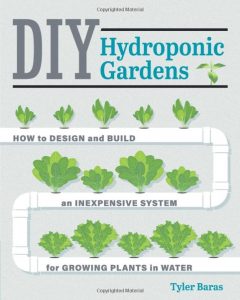 The book, appropriately titled “DIY Hydroponic Gardens: How to Design and Build an Inexpensive System for Growing Plants in Water” by Tyler Baras shares plans for building a variety of types of hydroponic systems using basic building materials like gutters and lumber, drip irrigation tubing and fittings, and various other bits and bobs. Tyler had been a featured speaker for the West Virginia Urban Agriculture Conference that I started and hosted when I worked for WVU Extension, so the book was on my radar – I placed an order. (Note: I don’t get a kickback for sharing the book – just sharing a good resource that happens to be from a friend.)
The book, appropriately titled “DIY Hydroponic Gardens: How to Design and Build an Inexpensive System for Growing Plants in Water” by Tyler Baras shares plans for building a variety of types of hydroponic systems using basic building materials like gutters and lumber, drip irrigation tubing and fittings, and various other bits and bobs. Tyler had been a featured speaker for the West Virginia Urban Agriculture Conference that I started and hosted when I worked for WVU Extension, so the book was on my radar – I placed an order. (Note: I don’t get a kickback for sharing the book – just sharing a good resource that happens to be from a friend.)
Teaching Hydroponics to an Unlikely Audience

As luck would have it, I had an opportunity to put the book, and my DIY hydroponic skills, to the test. Our university does quite a bit of work with and in Rwanda and in May I had the opportunity to travel to Rwanda as part of a study abroad program with my Ph.D. advisor. Rwanda is a very small country, just under the size of Massachussets, with a very big population by comparison – 12 million vs 7 million! Feeding that many people is a struggle, and even though Rwanda produces a lot of produce (and more lucrative export crops like coffee and tea), it still imports a lot of its fruits and vegetables. We were studying how innovation spreads in rural areas, and just before our trip I found a news article sharing that there would be an upcoming $8M USD ($8B RWF) investment in hydroponics in the country in order to increase production on the limited amount of land available.
In June I was scheduled to teach a group of Rwandan exchange students that are part of a sponsored program at the university, and remembering the planned investment in hydroponics I planned to add DIY hydroponics to the curriculum. This is fitting, since most small-scale operations would rely on finding what materials would be locally available. While the operations started by the investment would likely bring in “real” hydroponic systems, if small scale producers want to use the technology or if individuals want to build skills, they’re going to have to use what is at hand.
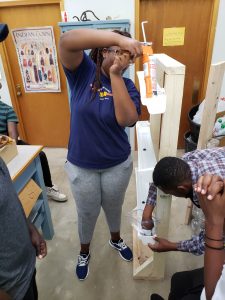
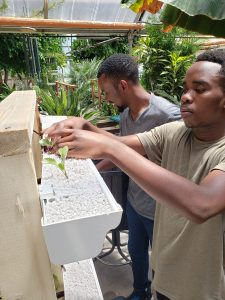
It was interesting teaching an audience who were interested in learning about the new technology, but have little experience or general knowledge on the subject. Even more interesting was the fact that many of the students had not used or even seen some of the basic power tools we used in building the system. I’m no shop teacher, but in the end the students not only learned a little bit about hydroponics and hydroponic systems, but also some skills using tools that they can apply in other applications.
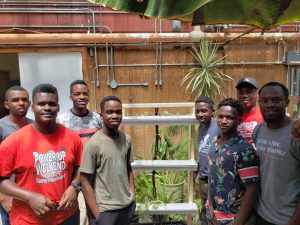
Hydroponics, Aeroponics, & Aquaponics – Oh My!
Earlier I mentioned that there are differences between hydroponics, aeroponics, and aquaponics. In some ways, they use similar basic setups. All are based on soil-less growing using an inert media to support plants, supplying nutrients and water directly to the plant roots, and providing light to the plants using either natural sunlight or supplemental lighting. Differences come from the source of plant nutrients and from how they are delivered to the plant. I thought I’d take a few minutes to talk about the basics of each of the techniques so you can understand the differences just in case you want to buy or build your own system. If there’s interest, I hope to focus on hydroponics and controlled environment agriculture over my next few blog posts – tell me what you’re interested in learning.
Most people are familiar with the concept of hydroponics. This technique relies on roots being submerged in a nutrient-rich solution where the nutrient content is engineered from a variety of mineral sources. There are a variety of different systems (that will hopefully be the subject of an upcoming blog) where the root zone interacts directly with the solution. In some cases, roots are submerged in a large volume of solution while in others a film or shallow stream of water flows through the root zone. Systems where roots are submerged in the solution may simply be a large reservoir where the plants float on top where systems relying on flow may involve a pump. Movement of water adds another plant need -oxygen, which is required for respiration by the roots. In systems where there is no flow, air is often pumped in to provide oxygen.
Most flowing systems are recirculating, where the solution returns to a reservoir and is pumped back into a reservoir to be reused. While it may seem counterintuitive, these recirculating water based growing systems have been touted as production methods that conserve water. That’s why some of the leading hydroponic production and research comes from areas of the world where water is scarce. Less common are flow through systems where water and nutrients are not recaptured but discarded after initial use.
Aeroponic systems have much of the same basic setup but instead of the roots interfacing directly with water solution it is applied as a pressurized mist. These systems generally use a much smaller volume of water, but there are some drawbacks. Failure of the system, such as an electric outage or clogging of the nozzles that pressurize the mist (which is a common occurrence) can quickly result in plant failure since roots can dry out quickly. Several systems that are sold commercially that market themselves as aeroponic, such as the AeroGarden or Tower Gardens, are more similar to a flowing hydroponic system than a pressurized mist aeroponic system.
The plant growing structures of aquaponics are similar to those of hydroponics, with the addition of larger reservoirs to accommodate the addition of aquatic livestock such as fish (or sometimes crustaceans). The waste produced by the stock provide the nutrients needed by the plants rather than an engineered nutrient solution. These systems require having the technical knowledge to meet the needs of the aquatic stock and balancing those with the needs of the plants. The addition of the aquatic stock also introduces a microbiome of bacteria and fungi, many of which are required for animal health but can also introduce pathogens that can negatively affect human health.
Are you interested in learning more about these systems? What do you want learn about in hydroponic or other systems? Let me know in the comments and I’ll try to base some future articles on what our readers are interested in.
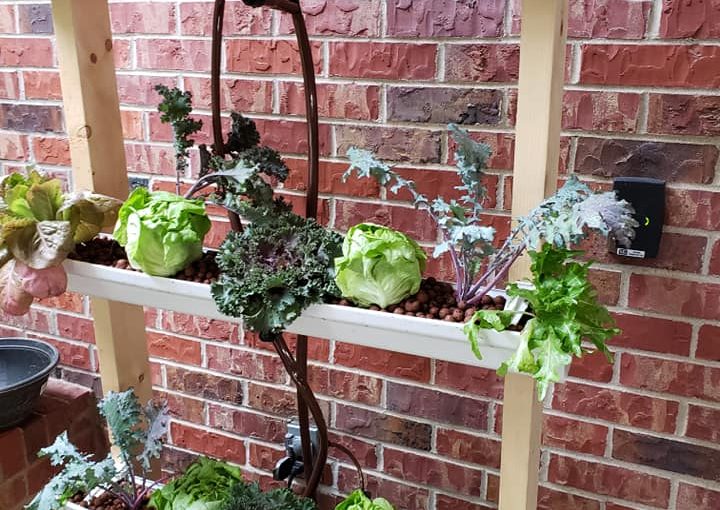
I get many questions about aquaculture systems when I participate in Master Gardener talks, particularly a talk I give on growing microgreens. I am not aware of much peer reviewed information on the subject, and I have to tell my students that. Please keep researching, experimenting and publishing!
How about the nutrient solution–will it be complicated? expensive? Since I don’t use fertilizers in my garden, how would I feel about using it?
Jane,
For small-scale home systems the easiest approach is to use a pre-made nutrient source. Think of it as mixing up a liquid fertilizer, only it has all the plant nutrients not just the macronutrients. Since there’s no soil to supply any of the nutrients, you have to supply everything. Plants don’t care if the nutrients come from soil or from a bag. The mixes are a little more expensive than a regular liquid fertilizer, but you use a small amount in a small system so the cost isn’t too bad. Of course, it all depend on what you are producing and how densely you are growing.
esp interested in costs …. ie: how to do this affordably. w/existing sunshine(thus w/out artificial light)
Costs related to lighting and temperature control are dependent in large part to crop selection. Crops with lower inputs (and therefore lower costs) are lettuce and leafy greens. If you have an area where you can grow the crops with no or low additional light or heat production costs will be lower. If you’re growing warm-season fruiting crops like tomatoes, cucumbers, or peppers you’ll need to supplement a much higher level of light and heat.
I am interested in outdoor hydroponics as my soil space is limited and poor quality. Experimented with a small scale floating system this past season. Would like to know more on organic fertilizers and pumps. Thank you
Bubbleponics will help alleviate clogged tubing. Recirculating constantly works for small(4-6 plants) grow in 10 gallon reservoir.
Good morning! I am interested in learning to grow with areoponics. I have already built a 2 bucket system with one reservoir.
My question is this what size misting nozzles am I supposed to use . The spray rips I going that I could get to work were the little red 360 degree sprayers now I now these work because I’ve seen it with my own eyes, but the spray is not a mist. IVs more of a stream. All the research that I have done tells me I need a fine mist sprayer and a pump to push them
Christopher – Not only do you have to find the right nozzles, but you do have to have a pump that produces enough pressure in the system to get them to work. Without the pressure you’ll probably get something like the stream you’re talking about. This is one reason that aeroponics is pretty difficult, especially for home growers. Another issue is that the opening in these mist nozzles is so small that they get blocked really easily. Any particulate in the water, build up of fertilizer salts, or even the biofilm that forms from bacteria in the water will clog these, and then you’re plant dies. That’s why I usually recommend hydroponics over aeroponics for home growers. If you want to replicate something like aeroponics without dealing with the pressure or clogging issues, you could use something like a regular drip irrigation emitter or the emitters that you have that are trickling and place them at the top of the bucket so that the stream of water runs down the roots. This is actually how those Aerogarden systems work – it’s not really aeroponics but something like a vertical NFT system. And this is what most home growers use (and what I’d recommend that you do).
IF you want to try actual mist aerpononics, I found several growers recommending a nozzle by Tefen. You can find them here. However, you’ll have to find a pump that can pressurize the system to 40-45 psi (which is probably beyond the ability of a regular pond/aquarium pump, and will have to use some other equipment, sucha as a pre-pressure accumulator tank, pressure switch, and more to get a system to work. You can find all the necessary steps in this non-academic article.